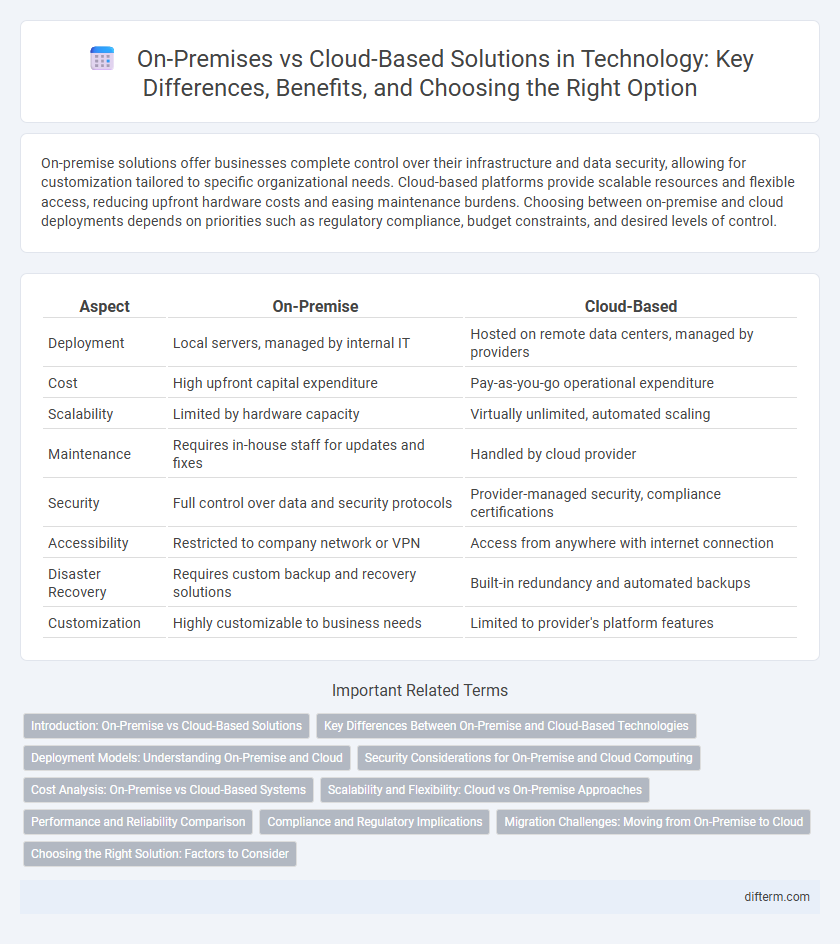On-premise solutions offer businesses complete control over their infrastructure and data security, allowing for customization tailored to specific organizational needs. Cloud-based platforms provide scalable resources and flexible access, reducing upfront hardware costs and easing maintenance burdens. Choosing between on-premise and cloud deployments depends on priorities such as regulatory compliance, budget constraints, and desired levels of control.
Table of Comparison
| Aspect | On-Premise | Cloud-Based |
|---|---|---|
| Deployment | Local servers, managed by internal IT | Hosted on remote data centers, managed by providers |
| Cost | High upfront capital expenditure | Pay-as-you-go operational expenditure |
| Scalability | Limited by hardware capacity | Virtually unlimited, automated scaling |
| Maintenance | Requires in-house staff for updates and fixes | Handled by cloud provider |
| Security | Full control over data and security protocols | Provider-managed security, compliance certifications |
| Accessibility | Restricted to company network or VPN | Access from anywhere with internet connection |
| Disaster Recovery | Requires custom backup and recovery solutions | Built-in redundancy and automated backups |
| Customization | Highly customizable to business needs | Limited to provider's platform features |
Introduction: On-Premise vs Cloud-Based Solutions
On-premise solutions require organizations to host and manage their own hardware and software, offering greater control, customization, and data security but often involve higher upfront costs and maintenance efforts. Cloud-based solutions provide scalable, flexible access to computing resources and applications via the internet, reducing capital expenses and enabling remote collaboration. Enterprises typically evaluate factors such as compliance requirements, IT infrastructure, and budget constraints when deciding between on-premise and cloud environments.
Key Differences Between On-Premise and Cloud-Based Technologies
On-premise technology requires local hardware installation and complete control over data security, offering customization tailored to specific organizational needs. Cloud-based technology provides scalable resources through internet access, enabling rapid deployment and cost-efficiency by reducing upfront infrastructure investments. Data management in on-premise solutions depends on internal IT teams, whereas cloud platforms leverage third-party providers for maintenance, updates, and backup services.
Deployment Models: Understanding On-Premise and Cloud
On-premise deployment involves hosting software and infrastructure within a company's physical facilities, providing direct control over data, security, and customization options. Cloud-based deployment enables access to applications and storage via remote servers managed by third-party providers, offering scalability, reduced IT maintenance, and pay-as-you-go pricing models. Choosing between on-premise and cloud depends on factors such as compliance requirements, budget constraints, and desired flexibility in resource management.
Security Considerations for On-Premise and Cloud Computing
On-premise computing offers direct control over data security with in-house management of firewalls, access protocols, and physical infrastructure, minimizing external vulnerabilities. Cloud-based solutions leverage advanced encryption, continuous monitoring, and compliance certifications such as ISO 27001 and SOC 2 to ensure robust protection and regulatory adherence. Evaluating specific organizational needs around data sensitivity, regulatory requirements, and resource availability is essential when choosing between on-premise and cloud security frameworks.
Cost Analysis: On-Premise vs Cloud-Based Systems
On-premise systems require significant upfront capital expenditure for hardware, software licenses, and maintenance, whereas cloud-based solutions shift costs to a subscription model with predictable monthly fees. Cloud services reduce total cost of ownership by eliminating expenses related to physical infrastructure, power, cooling, and IT staffing. Cost benefits of cloud systems are amplified by scalability and reduced downtime, enabling organizations to allocate budget towards innovation rather than operational overhead.
Scalability and Flexibility: Cloud vs On-Premise Approaches
Cloud-based solutions offer unparalleled scalability and flexibility by enabling organizations to rapidly adjust resources and deploy applications globally without significant upfront investment. On-premise infrastructure often involves fixed capacity and longer deployment cycles, limiting agility and scalability in response to fluctuating workloads. Hybrid models combine on-premise control with cloud scalability, providing tailored flexibility for diverse business demands.
Performance and Reliability Comparison
On-premise infrastructure offers direct control over hardware resources, often resulting in low latency and predictable performance for mission-critical applications, while cloud-based solutions leverage global data centers and scalable architectures to maintain high availability and fault tolerance through redundancy. Performance in cloud environments can fluctuate due to multi-tenancy and network variability, yet advanced load balancing and auto-scaling capabilities enhance overall reliability. Enterprises prioritize on-premise systems when consistent latency and control are paramount, whereas cloud deployments excel in disaster recovery and uptime guarantees with service-level agreements (SLAs) often exceeding 99.9%.
Compliance and Regulatory Implications
On-premise solutions offer greater control over data residency and security protocols, easing compliance with strict regulations like GDPR and HIPAA by enabling direct management of sensitive information. Cloud-based platforms provide scalable security frameworks that meet industry standards, but require thorough vendor assessments to ensure adherence to compliance mandates. Organizations must evaluate regulatory requirements alongside data sovereignty and audit capabilities to determine the optimal deployment model for their technology infrastructure.
Migration Challenges: Moving from On-Premise to Cloud
Migrating from on-premise infrastructure to cloud-based platforms involves addressing challenges such as data security, compatibility issues, and downtime risks. Enterprises must manage complex data transfer processes while ensuring compliance with regulations like GDPR and HIPAA. Effective migration strategies prioritize thorough assessment, robust backup solutions, and seamless integration with existing systems to minimize operational disruption.
Choosing the Right Solution: Factors to Consider
Evaluating factors such as data security, scalability, and total cost of ownership is crucial when choosing between on-premise and cloud-based solutions. On-premise systems offer greater control and customization but require significant upfront investment and ongoing maintenance. Cloud-based solutions provide flexibility, rapid deployment, and lower initial costs, making them ideal for businesses prioritizing agility and reduced IT overhead.
on-premise vs cloud-based Infographic

 difterm.com
difterm.com